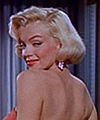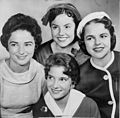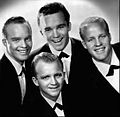Talk:Hairstyles in the 1950s
A fact from Hairstyles in the 1950s appeared on Wikipedia's Main Page in the Did you know column on 14 October 2012 (check views). The text of the entry was as follows:
|
| This article is rated Start-class on Wikipedia's content assessment scale. It is of interest to the following WikiProjects: | |||||||||||
| |||||||||||
Problems
[edit]Errors:
- The "beehive" didn't come in until the 1960s.
- The bouffant. It wasn't referred to as "The bouffant". "Bouffant" was used, correctly, as an adjective. It means "puffy" or "like a full sack". You can refer to "a bouffant hairstyle".
- Bouffant hair was only just beginning to come in at the end of the decade. If you are going to write about it at all, then it needs to be in the context of what was to follow. The beginnings of "bouffant" led to the "big hair" of the 60s.
- Buddy Holly and so-called "geek chic". I have removed the statement that "Buddy Holly was a proponent of "geek chic".
- The word "geek" was not in common use in the 50s.
- Buddy Holly's neat, suited look was "the norm". Nearly every performer wore a suit and tie on stage. These things, and a well-groomed hairstyle did not equate with "geek".
- The only thing that distinguished Buddy Holly was his thick-rimmed spectacles. At that date the only alternative were metal rims and they were regarded as "Grandpa spectacles". No young man would have worn them unless he was so poor that they were all he could afford.
- Nowadays that neat suit and spectacles suggested suggest "geek".
- The word "chic" was only just coming into common use. It was applied to only the sleekest of French and Italian styling. Audrey Hepburn was regarded as "chic". Grace Kelly was not chic because wearing full skirts and hair that was arranged softly was not "chic". Little black dresses were chic. A Chanel suit was chic. Christian Dior's designs were only sometimes "chic". No-one would have referred to Buddy Holly as "chic".
- Not enough emphasis is given to the fact that the vast majority of men wore "short back and sides" and a "combed-back" front as they had through the thirties and forties.
- "duck's ass" wasn't used in polite speech.
My main problem with this article is that it lists and describes hairstyles and products but gives no overall picture. It also give no sense of how these styles may have evolved out of those of the previous decade, or what they were to lead to.
If I was going to summarise the styles of the 1950s I would say that female style emphasised a "well-groomed" appearance. Women's hair during WWII and the austerity post war years was often long and arranged fairly elaborately because it was the only ornament a woman could afford. The 50s changed that.
- The 50s brought in a much more natural look. At least, the aim was "natural", but was often achieved by very careful cutting and perming. Women at this date did not tease their hair as the did in the sixties, add false hairpieces, or arrange their hair in a highly formal manner over pads and with bobby pins to hold it in place, as they had in the 40s.
- Women never went to town, to church or any function, during the daytime, without a hat. Hair was always cut and styled so that a hat could be worn over it.
- Well-groomed women such as Grace Kelly wore hair that was side-parted, and carefully cut and arranged so that it fell sleekly and curled under. The hair was supposed to frame the face without screening it. Any woman whose hair fell over her face either grew it longer so that it didn't, or wore a fringe.
- No-one ever wore a long fringe. It was considered the sign of an imbecile. Fringes were cut always above the eyebrows in the 50s.
- A slight wave in the hair was considered ideal because it helped the hair sit neatly. Queen Elizabeth II's hair was absolutely perfect for the period and no doubt affected the way that women who did not have a wave, had their hair permed. Perms were very common.
- Women at this period didn't wear straight bobs, unless they had only a thin, sleek amount of hair. Or unless they were "arty". Wavy bobs, with bangs were worn particularly in the early part of the decade. Close-cropped curls were fashionable (the Poodle look). When Audrey Hepburn wore "the Pixie look" which was razor-cut, layered and raggedy, it was treated with suspicion. It appears to have been based on the hair of Tinker-Bell in Walt Disney's Peter Pan. (For some reason I have never been able to fathom, Disney referred to Tink as a "Pixie", not as a "Fairy" which is the way that J.M.Barrie wrote it!)
- Pageboys were popular. They were worn with a short fringe, and with the hair cut to the shoulders at an even length the whole way round, and either turned up or under at the bottom. Girls would use jumbo-rollers to achieve that effect.
- Little girls wore fringed bobs, but more often their hair was side-parted and tied on one side with a bow. From the mid 50s long hair and plaits became increasingly popular. No little girls ever wore long floing hair to school. It was always neatly plaited, or tied in two bunches with hair-ribbon. Nylon hair ribbons came in at this time and were a blessing as they stayed on, didn't fray at the ends, and didn't need pressing. They were tied in bows. If the ends hung down, some friend would promptly retie them. Little girls didn't usually wear ponytails. They were a teenage style. They were usually tied in a bow with a crisp, nylon hair-ribbon. one to two inches wide
- Teenagers wore pageboys and ponytails. They also wore the Poodle cut and Pixie cut. The pony-tail was almost exclusively a teenage style at this time.
- Women who were going grey would tint their hair or have it dyed to match. Changing ones hair colour was uncommon. Peroxide blondes were regarded as tarts or show-girls. Nice women didn't peroxide their hair.
- Women who were doing house work or manual work, or working with food tied their hair up, or back, in a scarf, or put it in a bun or hairnet, or wore the hat provided.
Men's hairstyles were always groomed, even the most rebellious ones.
- Short back and sides was by far the most common, with a side part, and combed back at the front.
- Older men never went out without a hat.
- Almost all men wore Vaseline, hair oil (Californian Poppy) or Brylcreem to keep it sleek. The more elaborate the style, the more Vaseline was needed.
- The "crew cut" was most common among young men who were promoting a "clean-cut", "wholesome", "sporting" image.
- A "college cut" was also a wholesome clean-cut look, just a little longer than a crew cut, so that the hair lay flat on the head, and was often parted on the side. It was commbed forward or back at the front, and down or back at the sides, depending on length. A girl's mother would be much more happy to see her "dating" a boy with a crew cut or college cut than a quiff. Neither a crew cut, nor a college cut required hair-oil or styling. A college cut was nothing like the exaggerated windblown, forward-combed styles that go by the name today. It was essentially a minimum-maintenance style.
- The term "pompador" was used for male haircuts (and very occasionally female cuts) where the person's hair had enough "body" or "root strength" to stand up in a springy way. (This is more common with men). So men with thick springy straight hair would wear it a little longer at the front and comb it back smoothly with some elevation owing to the nature of the hair. Men with strong grey hair often achieved this look very well.
- Young men achieved a similar appearance with lots of Vaseline. It wasn't called a "Pompador" when young men wore it. It was a "Greaser", a "Rockabilly", or (in Australia) a "Bodgie" cut.
- A Greaser cut had the longish sides greased back in wings, had the front combed upwards and (if the hair had enough body) straight back, but more often flicked to one side. The hairline at the back of the neck was usually straight. An essential part of the whole were "side burns", which were either beard, or a longish growth of head hair in front of the ears. Also called "louse ladders".
- A variant of the pompador was to comb the hair slightly forward at the front and curl it upward in a quiff. These were not large by todays standards, not more than 2 inches tall.
- The flat top was an exaggerated style of the last years of the 50s, when the side wings and duck's ass were maintained, but the hair at the top of the head was cut as short as a crew cut so that it stood on end. The front of a flat-top always had a small quiff.
Hair was essentially "tidy" and almost always "off the face". It never hung in the eyes, unless the person was in bed.
The Rock and Roll era promoted exaggerated styles among young males. The film industry promoted glamourous waves and peroxide bleaching among women.
Don't ask me to reference this. I am an artist with a long memory.
Further to this, you cannot effectively use modern reproduction hairstyles to illustrate the genuine appearance. Modern hair gel and hair sprays allow much more exaggerated effects than were used in the 50s.
I have been through the Commons files and found a few more pics which I will put here.
Amandajm (talk) 05:16, 11 October 2012 (UTC)
Feel free to edit and improve it as you please.♦ Dr. Blofeld 10:06, 12 October 2012 (UTC)
-
Claudette Colbert and Patrock Knowles. Cobert has a bob, KNowles has a regular combed-back style. 1950
-
Fernando Lamas and Danielle Darrieux, Lamas has a pompador with a quiff and side-burns, Darrieuux has bangs. 1951
-
jean Simmons has a page boy with a side part, 1952
-
Marilyn, sleek peroxide, side parted with a bang. 1953
-
Grace Kelly 1954
-
Martha Hyer, 1954
-
Anne Francis c. 1955
-
Judy Tyler, 1957
-
Marilyn Monroe, 1957
-
Four Miss America contestants (1959-60)
-
Christian B. Anfinsen, 1950s.
-
Paddy Chayefsky, pompador style, 1958
-
Phil and Don Everly 1958
-
Jerry Lee Lewis, 1958
-
Gary, Lindsay, Philip and Dennis Crosby, 1959
-
Jacques Brel, 1955. This is a perfect example of a young man's hairstyle, including quiff and sideburns.
-
Johnny Carson, 1955
Parochial?
[edit]All very interesting, but should the article be renamed White American Hairstyles in the 1950s? --Hors-la-loi 08:06, 14 October 2012 (UTC)
















